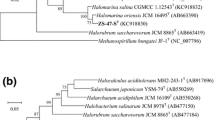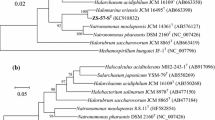Abstract
A halophilic archaeal strain, YJ-18-S1T, was isolated from Yangjiang marine solar saltern, Guangxi Province, China. Cells were pleomorphic, stained Gram-negative and formed red-pigmented colonies on agar plates. Strain YJ-18-S1T was able to grow at 20–55 °C (optimum 37 °C), at 0.9–4.8 M NaCl (optimum 2.6 M NaCl), at 0.005–1.0 M MgCl2 (optimum 0.3 MgCl2) and at pH 5.5–8.5 (optimum pH 7.0). The cells were lysed in distilled water, and the minimal NaCl concentration to prevent cell lysis was found to be 5 % (w/v). The major polar lipids of the strain were phosphatidic acid, phosphatidylglycerol, phosphatidylglycerol phosphate methyl ester, phosphatidylglycerol sulfate and sulfated mannosyl glucosyl diether. The 16S rRNA gene and rpoB′ gene of strain YJ-18-S1T were phylogenetically related to the corresponding genes of Halorubrum members (94.3–98.0 and 86.7–96.1 % similarities, respectively). The DNA G+C content of strain YJ-18-S1T was 66.2 mol%. The phenotypic, chemotaxonomic and phylogenetic properties suggested that strain YJ-18-S1T (=CGMCC 1.12554T = JCM 30030T) represents a new species of Halorubrum, for which the name Halorubrum rutilum sp. nov. is proposed.

Similar content being viewed by others
References
Cui H-L, Zhang W-J (2014) Salinigranum rubrum gen. nov., sp. nov., a new member of the family Halobacteriaceae isolated from a marine solar saltern. Int J Syst Evol Microbiol 64:1978–1983
Cui H-L, Tohty D, Zhou P-J, Liu S-J (2006) Halorubrum lipolyticum sp. nov. and Halorubrum aidingense sp. nov., isolated from two salt lakes in Xin-Jiang, China. Int J Syst Evol Microbiol 56:1631–1634
Cui H-L, Lin Z-Y, Dong Y, Zhou P-J, Liu S-J (2007) Halorubrum litoreum sp. nov., an extremely halophilic archaeon from a solar saltern. Int J Syst Evol Microbiol 57:2204–2206
Cui H-L, Zhou P-J, Oren A, Liu S-J (2009) Intraspecific polymorphism of 16S rRNA genes in two halophilic archaeal genera, Haloarcula and Halomicrobium. Extremophiles 13:31–37
Cui H-L, Gao X, Yang X, Xu X-W (2010) Halorussus rarus gen. nov., sp. nov., a new member of the family Halobacteriaceae isolated from a marine solar saltern. Extremophiles 14:493–499
Cui H-L, Yang X, Mou Y-Z (2011) Salinarchaeum laminariae gen. nov., sp. nov.: a new member of the family Halobacteriaceae isolated from salted brown alga Laminaria. Extremophiles 15:625–631
Dussault HP (1955) An improved technique for staining red halophilic bacteria. J Bacteriol 70:484–485
Ghai R, Pašić L, Fernández AB, Martin-Cuadrado A-B, Megumi Mizuno C, McMahon KD, Papke RT, Stepanauskas R, Rodriguez-Brito B, Rohwer F, Sánchez-Porro C, Ventosa A, Rodríguez-Valera F (2011) New abundant microbial groups in aquatic hypersaline environments. Sci Rep 1:135
Gonzalez C, Gutierrez C, Ramirez C (1978) Halobacterium vallismortis sp. nov. an amylolytic and carbohydrate-metabolizing, extremely halophilic bacterium. Can J Microbiol 24:710–715
Gupta RS, Naushad S, Baker S (2015) Phylogenomic analyses and molecular signatures for the class Halobacteria and its two major clades: a proposal for division of the class Halobacteria into an emended order Halobacteriales and two new orders, Haloferacales ord. nov. and Natrialbalesord. nov., containing the novel families Haloferacaceae fam. nov. and Natrialbaceae fam. nov. Int J Syst Evol Microbiol 65:1050–1069
Gutiérrez C, González C (1972) Method for simultaneous detection of proteinase and esterase activities in extremely halophilic bacteria. Appl Microbiol 24:516–517
Gutiérrez MC, Castillo AM, Pagaling E, Heaphy S, Kamekura M, Xue Y, Ma Y, Cowan DA, Jones BE, Grant WD, Ventosa A (2008) Halorubrum kocurii sp. nov., an archaeon isolated from a saline lake. Int J Syst Evol Microbiol 58:2031–2035
Han D, Cui H-L (2014) Halobacterium rubrum sp. nov., isolated from a marine solar saltern. Arch Microbiol 196:847–851
Han D, Cui H-L (2015) Halorubrum laminariae sp. nov., isolated from the brine of salted brown alga Laminaria. Antonie Van Leeuwenhoek 107:217–223
Infante-Domínguez C, Corral P, Sánchez-Porro C, Ventosa A (2015) Halovenus salina sp. nov., an extremely halophilic archaeon isolated from a saltern. Int J Syst Evol Microbiol. doi:10.1099/ijs.0.000370
Kim T-Y, Kim S-J, Park S-J, Kim J-G, Cha I-T, Jung M-Y, Lee S-A, Roh SW, Yim KJ, Itoh T, Rhee S-K (2013) Natronomonas gomsonensis sp. nov., isolated from a solar saltern. Antonie Van Leeuwenhoek 104:627–635
Kim M, Oh H-S, Park S-C, Chun J (2014) Towards a taxonomic coherence between average nucleotide identity and 16S rRNA gene sequence similarity for species demarcation of prokaryotes. Int J Syst Evol Microbiol 64:346–351
Kondo Y, Minegishi H, Echigo A, Shimane Y, Kamekura M, Itoh T, Ohkuma M, Takahashi-Ando N, Fukushima Y, Yoshida Y, Usami R (2015) Halorubrum gandharaense sp. nov., a novel alkaliphilic haloarchaeon from commercial rock salt. Int J Syst Evol Microbiol 65:2345–2350
Marmur J, Doty P (1962) Determination of the base composition of deoxyribonucleic acid from its thermal denaturation temperature. J Mol Biol 5:109–118
McDade JJ, Weaver RH (1959) Rapid methods for the detection of gelatin hydrolysis. J Bacteriol 77:60–64
McGenity TJ, Grant WD (1995) Transfer of Halobacterium saccharovorum, Halobacterium sodomense, Halobacterium trapanicum NRC 34021 and Halobacterium lacusprofundi to the genus Halorubrum gen. nov., as Halorubrum saccharovorum comb. nov., Halorubrum sodomense comb. nov., Halorubrum trapanicum comb. nov., and Halorubrum lacusprofundi comb. nov. Syst Appl Microbiol 18:237–243
Minegishi H, Kamekura M, Itoh T, Echigo A, Usami R, Hashimoto T (2010) Further refinement of Halobacteriaceae phylogeny based on the full-length RNA polymerase subunit B’ (rpoB ’) gene. Int J Syst Evol Microbiol 60:2398–2408
Narasingarao P, Podell S, Ugalde JA, Brochier-Armanet C, Emerson JB, Brocks JJ, Heidelberg KB, Banfield JF, Allen EE (2012) De novo assembly reveals abundant novel major lineage of Archaea in hypersaline microbial communities. ISME J 6:81–93
Oren A (2014) Taxonomy of halophilic Archaea: current status and future challenges. Extremophiles 18:825–834
Oren A, Ventosa A, Grant WD (1997) Proposed minimal standards for description of new taxa in the order Halobacteriales. Int J Syst Bacteriol 47:233–238
Oren A, Arahal DR, Ventosa A (2009) Emended descriptions of genera of the family Halobacteriaceae. Int J Syst Evol Microbiol 59:637–642
Qiu X-X, Mou Y-Z, Zhao M-L, Zhang W-J, Han D, Ren M, Cui H-L (2013a) Halobellus inordinatus sp. nov., from a marine solar saltern and an inland salt lake of China. Int J Syst Evol Microbiol 63:3975–3980
Qiu X-X, Zhao M-L, Han D, Zhang W-J, Cui H-L (2013b) Halorubrum rubrum sp. nov., an extremely halophilic archaeon from a Chinese salt lake. Antonie Van Leeuwenhoek 104:885–891
Tamura K, Peterson D, Peterson N, Stecher G, Nei M, Kumar S (2011) MEGA5: molecular evolutionary genetics analysis using maximum likelihood, evolutionary distance, and maximum parsimony methods. Mol Biol Evol 28:2731–2739
Tomlinson GA, Hochstein LI (1976) Halobacterium saccharovorum sp. nov., a carbohydrate-metabolizing, extremely halophilic bacterium. Can J Microbiol 22:587–591
Yim KJ, Cha I-T, Lee H-W, Song HS, Kim K-N, Lee S-J, Nam Y-D, Hyun D-W, Bae J-W, Rhee S-K, Seo M-J, Choi J-S, Choi H-J, Roh SW, Kim D (2014) Halorubrum halophilum sp. nov., an extremely halophilic archaeon isolated from a salt-fermented seafood. Antonie Van Leeuwenhoek 105:603–612
Zhang W-J, Cui H-L (2014a) Halorubrum salinum sp. nov., isolated from a marine solar saltern. Arch Microbiol 196:395–400
Zhang W-J, Cui H-L (2014b) Haloarchaeobius litoreus sp. nov., isolated from a marine solar saltern. Antonie Van Leeuwenhoek 105:1085–1090
Acknowledgments
This work was supported by the National Natural Science Foundation of China (No. 31370054), the 11th “Six Talents Peak” Project of Jiangsu Province (No. 2014-SWYY-021) and the Qinglan Project of Jiangsu Province and a project funded by the Priority Academic Program Development of Jiangsu Higher Education Institutions (PAPD).
Author information
Authors and Affiliations
Corresponding author
Additional information
Communicated by Erko Stackebrandt.
Electronic supplementary material
Below is the link to the electronic supplementary material.
Rights and permissions
About this article
Cite this article
Yin, S., Wang, Z., Xu, JQ. et al. Halorubrum rutilum sp. nov. isolated from a marine solar saltern. Arch Microbiol 197, 1159–1164 (2015). https://doi.org/10.1007/s00203-015-1159-3
Received:
Revised:
Accepted:
Published:
Issue Date:
DOI: https://doi.org/10.1007/s00203-015-1159-3




